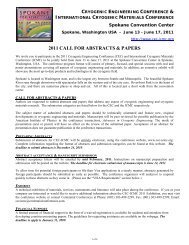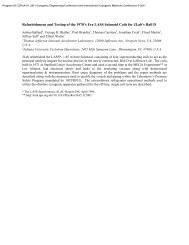CEC Abstracts in PDF format (as of 7/3/07) - CEC-ICMC 2013
CEC Abstracts in PDF format (as of 7/3/07) - CEC-ICMC 2013
CEC Abstracts in PDF format (as of 7/3/07) - CEC-ICMC 2013
You also want an ePaper? Increase the reach of your titles
YUMPU automatically turns print PDFs into web optimized ePapers that Google loves.
<strong>CEC</strong> 20<strong>07</strong> - <strong>Abstracts</strong><br />
C1-O-06 Ball Aerospace Hybrid Space Cryocoolers<br />
W. Gully, D.S. Glaister, P. Hendershott, V. Kotsubo,<br />
E.D. Marquardt, Ball Aerospace & Technologies<br />
Corp..<br />
This paper describes the design, development, test<strong>in</strong>g and<br />
performance at Ball Aerospace <strong>of</strong> a long life, hybrid (comb<strong>in</strong>ation <strong>of</strong><br />
Stirl<strong>in</strong>g and Joule-Thomson thermodynamic cycles) space<br />
cryocoolers. Hybrid coolers are synergistic comb<strong>in</strong>ation <strong>of</strong> two<br />
thermodynamic cycles which comb<strong>in</strong>es advantages <strong>of</strong> each cycle to<br />
yield overall improved performance. Hybrid cooler performance<br />
advantages <strong>in</strong>clude: 1) load level<strong>in</strong>g <strong>of</strong> large heat loads, 2) remote<br />
cryogenic cool<strong>in</strong>g with very low to negligible <strong>in</strong>duced vibration and<br />
jitter, 3) very low redundant (<strong>of</strong>f state) cooler penalties, 4) high power<br />
efficiency, especially at low temperatures, and 5) simplified system<br />
<strong>in</strong>tegration with capability to cross gimbals and no need for thermal<br />
straps or switches. Ball is currently develop<strong>in</strong>g hybrid coolers on<br />
several programs. The 35 K hybrid cooler provides 2.0 W at 35 K and<br />
8.5 W at 85 K with an emph<strong>as</strong>is on load level<strong>in</strong>g <strong>of</strong> high transient heat<br />
loads and remote, low vibration cool<strong>in</strong>g. The 10 K hybrid cooler<br />
provides 200 mW at 10 K, 700mW at 15 K, and 10.7 W at 85 K with<br />
an emph<strong>as</strong>is on power efficiency. In addition, Ball built and tested a<br />
complete hybrid cooler that met the requirements <strong>of</strong> the JWST Mid-<br />
Infrared Instrument (MIRI) cooler <strong>in</strong>clud<strong>in</strong>g provid<strong>in</strong>g 80 mW at 6 K<br />
and 100 mW at 18 K.<br />
C1-O-<strong>07</strong> Flight Qualified High Capacity Pulse Tube<br />
Cooler<br />
C. Jacob, T. Nguyen, J. Raab, Northrop Grumman<br />
Space Technology.<br />
The High Capacity Cryocooler Flight Qualified Cryocooler (HCC<br />
Qual) is designed to provide large capacity cool<strong>in</strong>g at 35K (2.3 Watts)<br />
and 85 K (14.3 Watts) for space applications which require cold focal<br />
planes and optics cool<strong>in</strong>g. The HCC Qual is built upon the heritage <strong>of</strong><br />
the High Capacity Cryocooler (HCC) with a coaxial cold head<br />
configuration. The coaxial configuration m<strong>in</strong>imizes the cooler<br />
par<strong>as</strong>itic and <strong>of</strong>fers superior cooler <strong>in</strong>tegration. Flight qualification <strong>of</strong><br />
this cryocooler <strong>in</strong>cludes thermal performance mapp<strong>in</strong>g over a range <strong>of</strong><br />
reject temperatures, launch vibration test<strong>in</strong>g and thermal cycl<strong>in</strong>g<br />
test<strong>in</strong>g. Acceptance test data will be presented.<br />
C1-O-08 Raytheon Dual-Use Cryocooler Progress<br />
R.C. Hon, C.S. Kirkconnell, Raytheon Space and<br />
Airborne Systems.<br />
Raytheon <strong>in</strong>itiated development <strong>of</strong> the Dual-Use Cryocooler (DUC) <strong>as</strong><br />
a way <strong>of</strong> bridg<strong>in</strong>g the gap between tactical and space cryocooler<br />
systems. The goal <strong>of</strong> the program is to produce a cryocooler system<br />
with 80% <strong>of</strong> the typical space system functionality at less than 20% <strong>of</strong><br />
the typical cost. A s<strong>in</strong>gle-stage pulse tube configuration w<strong>as</strong> selected<br />
due to its <strong>in</strong>herently low complexity. The compressor module is a<br />
dual-opposed, self balanced design, mak<strong>in</strong>g use <strong>of</strong> a flexure<br />
suspension and clearance gap scheme for long operational life. The<br />
drive electronics is b<strong>as</strong>ed on a robust tactical design, modified for<br />
additional functionality and hardened aga<strong>in</strong>st radiation typical <strong>of</strong> the<br />
space environment.<br />
Development <strong>of</strong> the DUC system h<strong>as</strong> progressed substantially over<br />
the p<strong>as</strong>t two years, <strong>in</strong>clud<strong>in</strong>g the design, build and test<strong>in</strong>g <strong>of</strong> a<br />
br<strong>as</strong>sboard thermo-mechanical unit (TMU). Demonstrated design<br />
simplification features and <strong>in</strong>itial test results are presented.<br />
Significant progress w<strong>as</strong> also made <strong>in</strong> terms <strong>of</strong> electronics<br />
development. Exist<strong>in</strong>g tactical <strong>as</strong>sets were modified for use with the<br />
DUC, <strong>in</strong>clud<strong>in</strong>g the addition <strong>of</strong> separate drive circuits for each<br />
compressor motor. The s<strong>of</strong>tware w<strong>as</strong> modified to enable features not<br />
found <strong>in</strong> typical tactical systems such <strong>as</strong> first-order active vibration<br />
cancellation. The br<strong>as</strong>sboard electronics test results are also<br />
presented.<br />
C1-P Large Scale Refrigerators and<br />
Liquefiers - II<br />
C1-P-01 Large scale helium liquefaction and<br />
considerations for site services for a plant located <strong>in</strong><br />
Algeria<br />
P. Froehlich, J.J. Clausen, L<strong>in</strong>de Kryotechnik AG.<br />
The large scale liquefaction <strong>of</strong> helium extracted from natural g<strong>as</strong> is<br />
depicted. B<strong>as</strong>ed on a block diagram the cha<strong>in</strong>, start<strong>in</strong>g with the<br />
pipel<strong>in</strong>e downstream <strong>of</strong> the natural g<strong>as</strong> plant to the f<strong>in</strong>al storage <strong>of</strong><br />
liquid helium is expla<strong>in</strong>ed. In<strong>format</strong>ion will be provided about the<br />
recent experiences dur<strong>in</strong>g <strong>in</strong>stallation and start-up <strong>of</strong> a bulk helium<br />
liquefaction plant located <strong>in</strong> Skikda, Algeria, <strong>in</strong>clud<strong>in</strong>g part load<br />
operation b<strong>as</strong>ed on a reduced feed g<strong>as</strong> supply.<br />
The local work<strong>in</strong>g and ambient conditions are described <strong>in</strong>clud<strong>in</strong>g<br />
challeng<strong>in</strong>g logistic problems like shipp<strong>in</strong>g and receiv<strong>in</strong>g <strong>of</strong> parts,<br />
qualified and semi-qualified subcontractors, b<strong>as</strong>ic provisions and tools<br />
at site, and precautions to sea water and ambient conditions.<br />
F<strong>in</strong>ally the differences <strong>in</strong> commission<strong>in</strong>g (technically and evaluation<br />
<strong>of</strong> time and work packages) to a European location and standards will<br />
be discussed.<br />
C1-P-02 Status <strong>of</strong> the refrigeration plant for the<br />
Electrostatic<br />
Cryogenic Storage R<strong>in</strong>g (CSR) at MPI-K <strong>in</strong> Heidelberg<br />
R. von Hahn, J. R. Crespo Lopez-Urrutia, H. Fadil,<br />
M. Grieser, K.-U. Kühnel, M. Lange, D. A. Orlov, R.<br />
Repnow, T. Sieber, D. Schwalm, J. Ullrich, A. Wolf,<br />
Max-Planck-Institute for Nuclear Physics; H. Quack,<br />
Ch. Haberstroh, Technische Universität Dresden; D.<br />
Zajfman, Weizmann Institute <strong>of</strong> Science.<br />
At the Max-Planck-Institute for Nuclear Physics <strong>in</strong> Heidelberg a nextgeneration<br />
electrostatic storage r<strong>in</strong>g for atomic and molecular ion<br />
beams is under construction. In contr<strong>as</strong>t to exist<strong>in</strong>g electrostatic<br />
storage r<strong>in</strong>gs our Cryogenic Storage R<strong>in</strong>g CSR will be cooled down to<br />
temperatures below 2 K. The low-temperature <strong>of</strong> the vacuum<br />
enclosure and all ion optical components decisively reduces the<br />
<strong>in</strong>fluence <strong>of</strong> the black-body radiation <strong>in</strong>cident onto the stored particles<br />
such that only the lowest rotational levels <strong>of</strong> radiatively active<br />
molecular ions will be occupied. Moreover, due to the excellent<br />
vacuum <strong>of</strong> up to 10E-15 mbar highly charged (radioactive) ions or<br />
antiprotons can be stored with sufficient life times. A concept for the<br />
cool<strong>in</strong>g <strong>of</strong> the storage r<strong>in</strong>g h<strong>as</strong> been developed and will soon be tested<br />
at a prototype with a length <strong>of</strong> 1/10 <strong>of</strong> the r<strong>in</strong>g. A commercial<br />
refrigerator h<strong>as</strong> been largely set up and is now <strong>in</strong> the commission<strong>in</strong>g<br />
ph<strong>as</strong>e. In this paper the refrigeration plant and first results <strong>of</strong> the testoperation<br />
will be presented.<br />
C1-P-03 The CERN LHC Refrigeration System<br />
P. Dauguet, G.M. Gistau-Baguer, P. Briend, B.<br />
Hilbert, E. Monneret, J.C. Villard, G. Marot, F.<br />
Delcayre, C. Mantileri, F. Hamber, J.C. Courty, P.<br />
Hirel, A. Cohu, H. Moussavi, Air Liquide.<br />
The LHC is the largest particle accelerator <strong>in</strong> the world. It is a<br />
superconduct<strong>in</strong>g mach<strong>in</strong>e over 27 kilometers. Its magnets and cavities<br />
require helium refrigeration and liquefaction <strong>in</strong> the temperature range<br />
1.8 K to 300 K. This is the largest cryogenic system <strong>in</strong> the world<br />
regard<strong>in</strong>g the needed cryogenic power : 144 kW equivalent power at<br />
4.5 K.<br />
The LHC cryogenic system is composed <strong>of</strong> 8 x 18 kW at 4.5 K<br />
refrigerators, 8 x 2.4 kW at 1.8 K refrigerators, 5 ma<strong>in</strong> valve boxes,<br />
more than 27 km <strong>of</strong> helium tranfer l<strong>in</strong>es and around 300 service<br />
modules connect<strong>in</strong>g the tranfer l<strong>in</strong>e to the magnet and cavity str<strong>in</strong>gs.<br />
Most <strong>of</strong> these components have been designed, manufactured,<br />
<strong>in</strong>stalled and started up by Air Liquide. Du to the huge size <strong>of</strong> the<br />
project, the eng<strong>in</strong>eer<strong>in</strong>g, construction and commissionn<strong>in</strong>g <strong>of</strong> the<br />
equipments have l<strong>as</strong>ted for 8 years, from first order <strong>of</strong> equipments <strong>in</strong><br />
1998 to l<strong>as</strong>t commissionn<strong>in</strong>g <strong>in</strong> 2006. Specifications, architecture and<br />
design <strong>of</strong> the major components <strong>of</strong> the LHC Refrigeration System will<br />
be presented <strong>in</strong> the present paper.<br />
Page 17 <strong>of</strong> 53






